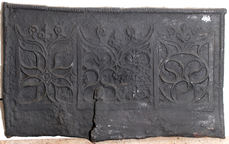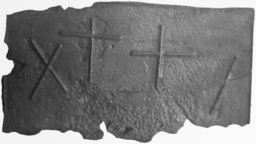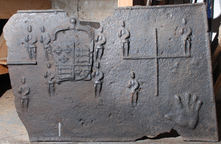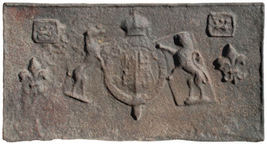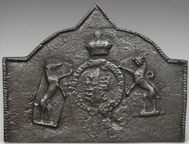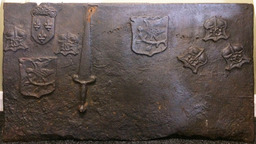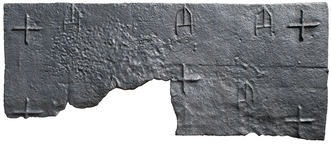-
444
Description: Rectangular; top and side edging formed from the repeated stamping of a short length of twisted rope; three gothic panels arranged horizontally, the centre one wider than the other two, each panel a symmetrical arrangement of tracery patterns with an inverted ogee arch on top incorporating two flowers; a separate fleur-de-lys stamp has been repeated above each panel.
Notes: The panels were probably derived from a dismantled wooden chest or hutch table, c.1500. Their gothic style belies the probable age of the fireback, such chests already being old when their parts might have been re-used. H.R. Schubert (1957, p.259) speculated that this fireback might have been imported from Cleves, where a furnace near Stolberg produced similar castings. That the same panels are on a fireback at Nymans, Handcross (no. 99), makes English manufacture more probable.
- Decoration tags:
- rectangular (shape)
- rope (edging)
- carved pattern panels
- architectural
- objects
Manufactured: in the early- to mid-16th century in the Weald area of England.
Current location: East Grinstead Museum, East Grinstead, West Sussex, England.
Museum number: LH000.796 (part of the Sussex Archaeological Society museum group)
Citation: Butterfield, W. R., 1916, 'Old Wealden Firebacks', The Connoisseur, 46, pp. 197-209.
Citation: Dawson, C., 1903, 'Sussex Iron Work and Pottery', Sussex Archaeological Collections, 46, pp. 1-54.
- Attached to series:
- Gothic panel series
- Furniture stamp firebacks
-
1046
Description: Sub-rectangular shape; twisted rope edging (top and sides); two crosses between two saltires, all formed of straight lengths of twisted rope and irregularly arranged.
Notes: A poorly cast, and probably early, fireback. Formerly part of the J. H. Every collection.
- Decoration tags:
- rectangular (shape)
- rope (edging)
- simple stamps
- apotropaic
- objects
Manufactured: in the early- to mid-16th century in the Weald area of England.
Current location: Anne of Cleves House, Southover High Street, Lewes, East Sussex, England.
Museum number: LH000.917 (part of the Sussex Archaeological Society museum group)
- Attached to series:
- Rope design firebacks
-
661
Description: Fragment; quasi-rectangular; twisted rope edging (top and sides), cavetto edging at bottom; originally, probably a symmetrical arrangement comprising a central, crude crowned, Tudor royal shield, with a standing human figure, its right arm bent at the elbow and its left arm crossing its waist, repeated in upper and lower positions on each side of the shield; to left and right, a twisted rope length repeated in the form of a cross, with the human figure placed above each transverse end and another below the cross and towards the shield; in the bottom corner(s), a (left) hand print.
Notes: The same crowned shield and use of hand print can be seen on a fireback at Etchingham (no. 60), indicating a common source.
Arms: Tudor royal
- Decoration tags:
- rectangular (shape)
- simple stamps
- carved stamps
- armorial
- royal
- humans
- objects
Manufactured: in the early- to mid-16th century in the Weald area.
Current location: Hole Park, Rolvenden, Kent, England.
-
664
Description: Rectangular; moulded border with bead edging derived from wooden strips (top and sides); top left, a saltire of the same moulding as the border, between roughly shaped D and R, both reversed.
Notes: The border appears to be in pieces of different lengths, probably from redundant furniture. Illustrated by Christy, 1908, in the possession of Mr E. Simmons of Lewes.
Inscription: D R
- Decoration tags:
- rectangular (shape)
- complex, furniture-derived (edging)
- simple stamps
- individual letters
- apotropaic
- text
- objects
Manufactured: in the early- to mid-16th century in the Weald area of England.
Current location: in private hands, Rolvenden, Kent, England.
- Attached to series:
- Initials only firebacks
-
470
Description: Rectangular; twisted rope edging (top and sides); central Tudor royal shield with encircling garter (motto reversed), separate greyhound and lion supporters, separate crown; rectangular bordered stamp with an animal facing to the right, repeated once above and on each side of the armorial; bold fleur-de-lys stamp repeated once on each side of the armorial below the other stamp; all irregularly positioned.
Notes: The armorial and fleurs-de-lys are seen together on a plate at Alfriston Clergy House.
Copies of this fireback are known.
Arms: Tudor royal (prob. Henry VIII)
- Decoration tags:
- rectangular (shape)
- rope (edging)
- carved stamps
- heraldic
- armorial
- royal
- objects
Manufactured: in the early- to mid-16th century possibly at Pounsley Furnace, Framfield in the Weald area of England.
Current location: not known.
Citation: Lloyd, N., 1925, 'Domestic Ironwork I', Architectural Review, 58, pp. 58-67.
- Attached to series:
- Pounsley series
- Tudor royal armorial firebacks
-
51
Description: Arched rectangular shaped, topped with a triangle; twisted rope edging (top and sides only); inverted Tudor royal shield and Garter, crown above, greyhound and lion supporters (see example at Alfriston Clergy House). Two horizontal planklines.
Notes: A uniquely shaped fireback, the inverted shield and Garter indicate that they formed a separate stamp from the crown; other firebacks with these stamps have the shield and Garter the correct way round. A frequently copied fireback; a larger version has a bottom extension.
Copies of this fireback are known.
Inscription: HONE SOVT QUEY MAL Y PENSE
Arms: Tudor royal (prob.Henry VIII)
- Decoration tags:
- rectangular with round arch and triangle above (shape)
- rope (edging)
- carved stamps
- planklines
- heraldic
- armorial
- royal
Manufactured: in the early- to mid-16th century possibly at Pounsley Furnace, Framfield in the Weald area of England.
Current location: Courtlands, Taunton, Somerset, England.
- Attached to series:
- Pounsley series
- Tudor royal armorial firebacks
-
1109
Description: Rectangular; plain edging; asymmetrical arrangement of stamps: top right, three 'renaissance' style shield stamps with a 'PL' monogram above two [?]bougets, in a triangular arrangement bases uppermost; top centre, a shield, indented at the top, charged with a bird upon a branch; top left, crowned shield of France Modern between two inverted 'PL' monogram shields above a bird shield; to the right, a broad bladed dagger, point uppermost.
Notes: The dagger is of the cinquedea style, introduced from Italy in the early-16th century, length approx. 38cm; the bird shield stamp has been seen on other firebacks. Wilkinson's Auctioneers, Doncaster, 24 Feb 2019, lot 534 (£650).
Inscription: PL [in five shields]
Arms: 'France Modern'
- Decoration tags:
- rectangular (shape)
- none (edging)
- simple stamps
- carved stamps
- heraldic
- monogram
- armorial
- royal
- objects
Manufactured: in the early- to mid-16th century in the Weald area of England.
Current location: not known.
- Attached to series:
- Bird shield series
- Knife & Dagger stamp firebacks
-
636
Description: Rectangular; no edging; quasi-symmetrical arrangement of crosses and buckle outlines: a cross at each corner and one to right of middle, three buckles along the top and three buckles in triad, level with, and below, the central cross; two horizontal plank lines; lower left part of back missing due to wear and corrosion. The fireback has a small accumulation of iron slag on the reverse side, probably caused by a failure, by the founder, to tap off all the slag from the furnace hearth before casting.
Notes: The buckles, which could have been stamped using a branding iron, suggest a connection with the Pelham family. This is the fireback noted in 1861 at Warbleton Priory, Sussex, which the Pelhams endowed in 1413; the priory was dissolved in 1535 suggesting that the fireback dates from before then. The excrescence, left of centre, on the surface of the fireback was probably caused by molten iron being poured from a ladle into the sand mould and displacing some of the sand.
- Decoration tags:
- rectangular (shape)
- none (edging)
- simple stamps
- carved stamps
- planklines
- heraldic
- objects
Manufactured: in the early- to mid-16th century in the Weald area of England.
Current location: Anne of Cleves House, Southover High Street, Lewes, East Sussex, England.
(part of the Sussex Archaeological Society museum group)
- Attached to series:
- Pelham family firebacks
- Metalware stamp firebacks
